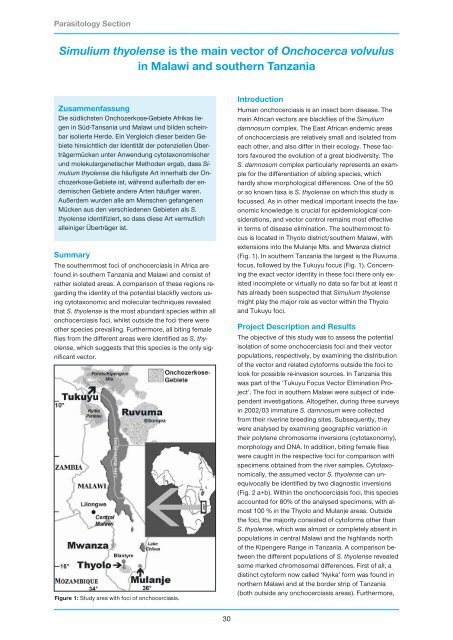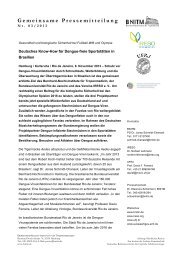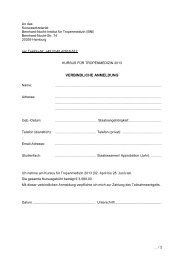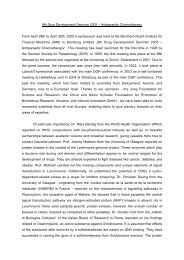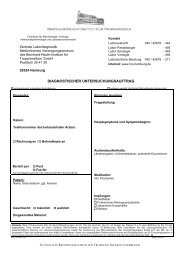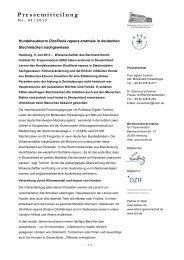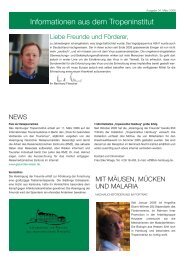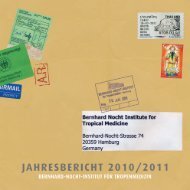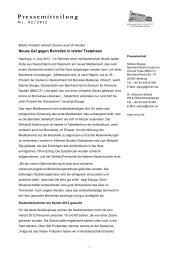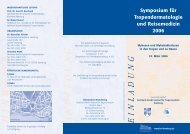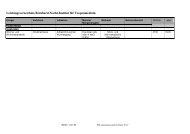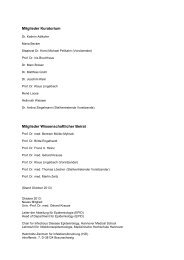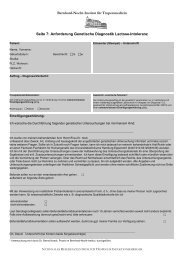Research Group Heussler (Malaria I) - Bernhard-Nocht-Institut für ...
Research Group Heussler (Malaria I) - Bernhard-Nocht-Institut für ...
Research Group Heussler (Malaria I) - Bernhard-Nocht-Institut für ...
Create successful ePaper yourself
Turn your PDF publications into a flip-book with our unique Google optimized e-Paper software.
Parasitology Section<br />
Simulium thyolense is the main vector of Onchocerca volvulus<br />
in Malawi and southern Tanzania<br />
Zusammenfassung<br />
Die südlichsten Onchozerkose-Gebiete Afrikas liegen<br />
in Süd-Tansania und Malawi und bilden scheinbar<br />
isolierte Herde. Ein Vergleich dieser beiden Gebiete<br />
hinsichtlich der Identität der potenziellen Überträgermücken<br />
unter Anwendung cytotaxonomischer<br />
und molekulargenetischer Methoden ergab, dass Simulium<br />
thyolense die häufigste Art innerhalb der Onchozerkose-Gebiete<br />
ist, während außerhalb der endemischen<br />
Gebiete andere Arten häufiger waren.<br />
Außerdem wurden alle am Menschen gefangenen<br />
Mücken aus den verschiedenen Gebieten als S.<br />
thyolense identifiziert, so dass diese Art vermutlich<br />
alleiniger Überträger ist.<br />
Summary<br />
The southernmost foci of onchocerciasis in Africa are<br />
found in southern Tanzania and Malawi and consist of<br />
rather isolated areas. A comparison of these regions regarding<br />
the identity of the potential blackfly vectors using<br />
cytotaxonomic and molecular techniques revealed<br />
that S. thyolense is the most abundant species within all<br />
onchocerciasis foci, whilst outside the foci there were<br />
other species prevailing. Furthermore, all biting female<br />
flies from the different areas were identified as S. thyolense,<br />
which suggests that this species is the only significant<br />
vector.<br />
Figure 1: Study area with foci of onchocerciasis.<br />
30<br />
Introduction<br />
Human onchocerciasis is an insect born disease. The<br />
main African vectors are blackflies of the Simulium<br />
damnosum complex. The East African endemic areas<br />
of onchocerciasis are relatively small and isolated from<br />
each other, and also differ in their ecology. These factors<br />
favoured the evolution of a great biodiversity. The<br />
S. damnosum complex particularly represents an example<br />
for the differentiation of sibling species, which<br />
hardly show morphological differences. One of the 50<br />
or so known taxa is S. thyolense on which this study is<br />
focussed. As in other medical important insects the taxonomic<br />
knowledge is crucial for epidemiological considerations,<br />
and vector control remains most effective<br />
in terms of disease elimination. The southernmost focus<br />
is located in Thyolo district/southern Malawi, with<br />
extensions into the Mulanje Mts. and Mwanza district<br />
(Fig. 1). In southern Tanzania the largest is the Ruvuma<br />
focus, followed by the Tukuyu focus (Fig. 1). Concerning<br />
the exact vector identity in these foci there only existed<br />
incomplete or virtually no data so far but at least it<br />
has already been suspected that Simulium thyolense<br />
might play the major role as vector within the Thyolo<br />
and Tukuyu foci.<br />
Project Description and Results<br />
The objective of this study was to assess the potential<br />
isolation of some onchocerciasis foci and their vector<br />
populations, respectively, by examining the distribution<br />
of the vector and related cytoforms outside the foci to<br />
look for possible re-invasion sources. In Tanzania this<br />
was part of the ‘Tukuyu Focus Vector Elimination Project’.<br />
The foci in southern Malawi were subject of independent<br />
investigations. Altogether, during three surveys<br />
in 2002/03 immature S. damnosum were collected<br />
from their riverine breeding sites. Subsequently, they<br />
were analysed by examining geographic variation in<br />
their polytene chromosome inversions (cytotaxonomy),<br />
morphology and DNA. In addition, biting female flies<br />
were caught in the respective foci for comparison with<br />
specimens obtained from the river samples. Cytotaxonomically,<br />
the assumed vector S. thyolense can unequivocally<br />
be identified by two diagnostic inversions<br />
(Fig. 2 a+b). Within the onchocerciasis foci, this species<br />
accounted for 80% of the analysed specimens, with almost<br />
100 % in the Thyolo and Mulanje areas. Outside<br />
the foci, the majority consisted of cytoforms other than<br />
S. thyolense, which was almost or completely absent in<br />
populations in central Malawi and the highlands north<br />
of the Kipengere Range in Tanzania. A comparison between<br />
the different populations of S. thyolense revealed<br />
some marked chromosomal differences. First of all, a<br />
distinct cytoform now called ‘Nyika’ form was found in<br />
northern Malawi and at the border strip of Tanzania<br />
(both outside any onchocerciasis areas). Furthermore,


